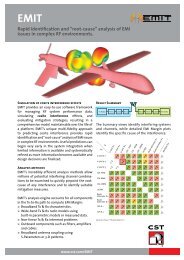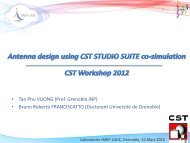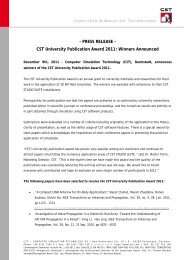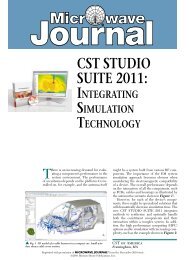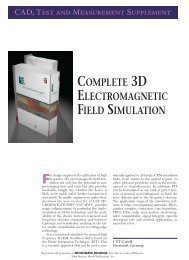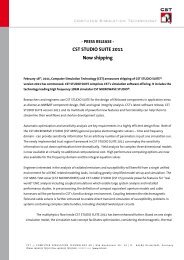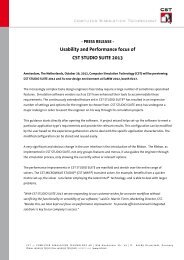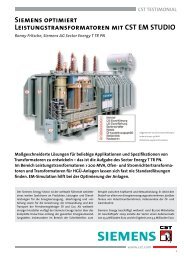Microwave Product Digest - CST
Microwave Product Digest - CST
Microwave Product Digest - CST
Create successful ePaper yourself
Turn your PDF publications into a flip-book with our unique Google optimized e-Paper software.
PAGE 58 • OCTOBER 2001 FEATURE ARTICLE MICROWAVE PRODUCT DIGEST<br />
Continued from pg 55<br />
complete electromagnetic behavior<br />
including skin effect losses and curvatures,<br />
the highly developed features of<br />
a 3D simulation tool are required.<br />
Furthermore, a very fine discretization<br />
around the metal foils is indispensable,<br />
especially to accurately predict<br />
the passband’s edge frequencies.<br />
Therefore, more than a hundred thousand<br />
single mesh elements, considerably<br />
varying in size (high aspect ratio)<br />
are required in order to model the<br />
device accurately. Although the geometry<br />
looks quite simple, the electromagnetic<br />
complexity of this highly<br />
resonant system and the described<br />
mesh requirements qualify it as an<br />
ideal benchmark candidate for the<br />
comparison of simulation engines.<br />
Various simulation methods behave<br />
significantly differently with respect<br />
to the numerical effort, especially<br />
when attacking larger numbers of<br />
mesh elements. Implicit algorithms<br />
(e.g. all frequency domain methods)<br />
behave in a strongly non linear way<br />
(in terms of computer resources) with<br />
increasing problem sizes, whereas<br />
explicit algorithms such as the FDTD<br />
and FIT method can handle large<br />
problems within a reasonable memory<br />
size and time.<br />
The simulation of the complete<br />
diplexer using <strong>CST</strong> MWS, a simulator<br />
based on the Finite Integration (FI)<br />
method is shown Figure 2. The<br />
advantage of <strong>CST</strong> MWS compared to<br />
conventional time domain codes is the<br />
precise geometrical representation<br />
even of curved shapes, achieved<br />
by the Perfect Boundary<br />
Approximation (PBA). This<br />
Figure 4: S21 as a function of frequency. Due to its tight integration with <strong>CST</strong> MICROWAVE<br />
STUDIO, all advantages of this general purpose EM tool are maintained in <strong>CST</strong> DESIGN<br />
STUDIO. As shown, the pass band transmission is reduced by more than 0.5 dB when<br />
considering skin effect losses.<br />
method avoids staircase approximation<br />
of curved structures, without giving<br />
up any advantages of the explicit<br />
time integration algorithm. Despite<br />
the outstanding speed and memory<br />
efficiency of <strong>CST</strong> MWS, compared to<br />
other 3D EM Simulators on the market,<br />
the complete 3D simulation of the<br />
2-arm diplexer takes a few hours on a<br />
standard desktop PC, so that advanced<br />
design strategies, including parameter<br />
sweeping and optimization runs, are<br />
not practical.<br />
Technology<br />
At this point, the benefit of the new<br />
program <strong>CST</strong> DESIGN STUDIO<br />
becomes obvious: its ability to speed<br />
up the described simulation without<br />
losing accuracy. <strong>CST</strong> DESIGN STU-<br />
DIO reaches this goal by splitting<br />
up a complex system into smaller<br />
components, described by component<br />
S-matrices. Taking into account higher<br />
order modes in the S-matrix<br />
description, the structure can be dissected<br />
even at locations where the<br />
fundamental mode alone is not sufficient<br />
to describe the electromagnetic<br />
coupling accurately.<br />
Particularly for resonant structures<br />
the gain in simulation time can be dra-<br />
Figure 3: User Interface of <strong>CST</strong> DESIGN STUDIO. The diplexer is split into smaller sub-components.<br />
Taking into account higher order mode coupling between the components ensures<br />
highly accurate simulation results - more than 10 times faster, compared conventional 3D<br />
simulations.<br />
matic: the structure can be split up<br />
into non-resonant parts, which are<br />
then analyzed much faster than structures<br />
with multiple narrowly spaced<br />
resonances. In addition, time domain<br />
simulators such as <strong>CST</strong><br />
MICROWAVE STUDIO have the<br />
possibility of speeding up a simulation<br />
by increasing the simulation bandwidth,<br />
therefore using a shorter stimulation<br />
pulse. Finally the simulation<br />
time for the whole structure is reduced<br />
to couple of minutes.<br />
Summary<br />
<strong>CST</strong> DESIGN STUDIO is a new<br />
tool for the fast design of passive high<br />
frequency devices. Even highly resonant<br />
structures can be split into nonresonant<br />
sub-components.<br />
The new approach is capable of<br />
taking skin effect losses as well as<br />
arbitrary curved structures and<br />
boundaries into account. Since the<br />
simulation time is reduced significantly<br />
compared to conventional<br />
tools, <strong>CST</strong> DESIGN STUDIO now<br />
even allows fast full parameterization<br />
and optimization studies for complex<br />
systems, while maintaining all<br />
required accuracy.<br />
<strong>CST</strong> DESIGN STUDIO is a<br />
package of high functionality which<br />
interfaces to different simulators or<br />
even measurement data, so that each<br />
component can be analyzed with the<br />
simulator best suited to the particular<br />
component. Furthermore, analytic<br />
models and/or libraries are available,<br />
which again speeds up the daily<br />
design work.<br />
The intuitive and easy to use interface<br />
is based on the latest software<br />
technology Figure 3. This enables the<br />
user to build up clear schematic drawings<br />
of complex structures and circuits,<br />
keeping a clear overview by<br />
adding text and graphic elements.<br />
<strong>CST</strong> OF AMERICA<br />
CIRCLE READER SERVICE NO. 5



